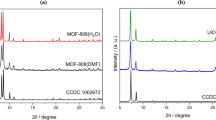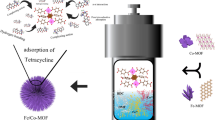Abstract
Graphene oxide (GO), nanosized Fe3O4 and zeolite imidazolate framework-8 (ZIF-8) were hybridized as a multifunctional sorbent for use in microextraction. The sorbent was characterized by SEM, TEM, XRD and FTIR. The composite is porous, has a high specific surface (> 600 m2·g−1) and is paramagnetic. The GO sheets are shown to act as carriers for the Fe3O4 nanoparticles and ZIF-8. The composite is a viable material for the preconcentration of atorvastatin and simvastatin from urine prior to their determination by HPLC with PDA detection. The limits of detection are 116 and 387 pg·mL−1, respectively. Recoveries from spiked urine samples range between 84.7 and 95.7%, with relative standard deviation of ≤4.5%. Enrichment factors range from 169 to 191. The method was successfully applied to the determination of atorvastatin in urine. Moreover, this sorbent is regenerable and recyclable for at least seven times without obvious decrease in performance.

A composite sorbent composed of a zeolite imidazolate framework, Fe3O4 and graphene oxide was applied to the extraction of statins in urine prior their determination by HPLC.





Similar content being viewed by others
References
Patel M, Kothari C (2017) Critical review of statins: a bio-analytical perspective for therapeutic drug monitoring. TrAC Trends Anal Chem 86:206–221. https://doi.org/10.1016/j.trac.2016.10.011
Diao X, Huestis MA (2017) Approaches, challenges, and advances in metabolism of new synthetic cannabinoids and identification of optimal urinary marker metabolites. Clin Pharmacol Ther 101(2):239–253. https://doi.org/10.1002/cpt.534
Esteve-Romero J, Albiol-Chiva J, Peris-Vicente J (2016) A review on development of analytical methods to determine monitorable drugs in serum and urine by micellar liquid chromatography using direct injection. Anal Chim Acta 926:1–16. https://doi.org/10.1016/j.aca.2016.04.026
Bylda C, Thiele R, Kobold U, Volmer DA (2014) Recent advances in sample preparation techniques to overcome difficulties encountered during quantitative analysis of small molecules from biofluids using LC-MS/MS. Analyst 139(10):2265–2276. https://doi.org/10.1039/c4an00094c
Panuwet P, Hunter RE, Jr., D’Souza PE, Chen X, Radford SA, Cohen JR, Marder ME, Kartavenka K, Ryan PB, Barr DB (2016) Biological matrix effects in quantitative tandem mass spectrometry-based analytical methods: advancing biomonitoring. Crit Rev Anal Chem 46 (2):93–105. doi:https://doi.org/10.1080/10408347.2014.980775
Soleymani J, Perez-Guaita D, Hasanzadeh M, Shadjou N, Jouyban A (2017) Materials and methods of signal enhancement for spectroscopic whole blood analysis: novel research overview. TrAC Trends Anal Chem 86:122–142. https://doi.org/10.1016/j.trac.2016.10.006
Wen Y, Chen L, Li J, Liu D, Chen L (2014) Recent advances in solid-phase sorbents for sample preparation prior to chromatographic analysis. TrAC Trends Anal Chem 59:26–41. https://doi.org/10.1016/j.trac.2014.03.011
Clark KD, Zhang C, Anderson JL (2016) Sample preparation for bioanalytical and pharmaceutical analysis. Anal Chem. https://doi.org/10.1021/acs.analchem.6b02935
Ghambarian M, Yamini Y, Esrafili A (2013) Liquid-phase microextraction based on solidified floating drops of organic solvents. Microchim Acta 180(7–8):519–535. https://doi.org/10.1007/s00604-013-0969-8
Pyrzynska K (2013) Use of nanomaterials in sample preparation. TrAC Trends Anal Chem 43:100–108. https://doi.org/10.1016/j.trac.2012.09.022
Xu J, Wu P, Ye E-C, Yuan B-F, Feng Y-Q (2016) Metal oxides in sample pretreatment. TrAC Trends Anal Chem 80:41–56. https://doi.org/10.1016/j.trac.2016.02.027
Peng J, Liu D, Shi T, Tian H, Hui X, He H (2017) Molecularly imprinted polymers based stir bar sorptive extraction for determination of cefaclor and cefalexin in environmental water. Anal Bioanal Chem 409(17):4157–4166. https://doi.org/10.1007/s00216-017-0365-z
Gonzalez-Fuenzalida RA, Moliner-Martinez Y, Prima-Garcia H, Ribera A, Campins-Falco P, Zaragoza RJ (2014) Evaluation of superparamagnetic silica nanoparticles for extraction of Triazines in magnetic in-tube solid phase microextraction coupled to capillary liquid chromatography. Nanomaterials (Basel) 4(2):242–255. https://doi.org/10.3390/nano4020242
Ligler FS, White HS (2013) Nanomaterials in analytical chemistry. Anal Chem 85(23):11161–11162. https://doi.org/10.1021/ac403331m
Gu ZY, Yang CX, Chang N, Yan XP (2012) Metal-organic frameworks for analytical chemistry: from sample collection to chromatographic separation. Acc Chem Res 45(5):734–745. https://doi.org/10.1021/ar2002599
Ouyang G, Vuckovic D, Pawliszyn J (2011) Nondestructive sampling of living systems using in vivo solid-phase microextraction. Chem Rev 111(4):2784–2814. https://doi.org/10.1021/cr100203t
Wang M, Niu Y, Zhou J, Wen H, Zhang Z, Luo D, Gao D, Yang J, Liang D, Li Y (2016) The dispersion and aggregation of graphene oxide in aqueous media. Nano 8(30):14587–14592. https://doi.org/10.1039/c6nr03503e
Ge D, Lee HK (2012) Zeolite imidazolate frameworks 8 as sorbent and its application to sonication-assisted emulsification microextraction combined with vortex-assisted porous membrane-protected micro-solid-phase extraction for fast analysis of acidic drugs in environmental water samples. J Chromatogr A 1257:19–24. https://doi.org/10.1016/j.chroma.2012.08.032
Ahmed I, Jhung SH (2014) Composites of metal–organic frameworks: preparation and application in adsorption. Mater Today 17(3):136–146. https://doi.org/10.1016/j.mattod.2014.03.002
Sleijfer S, van der Gaast A, Planting AS, Stoter G, Verweij J (2005) The potential of statins as part of anti-cancer treatment. Eur J Cancer 41(4):516–522. https://doi.org/10.1016/j.ejca.2004.12.009
Nováková L, Šatínský D, Solich P (2008) HPLC methods for the determination of simvastatin and atorvastatin. TrAC Trends Anal Chem 27(4):352–367. https://doi.org/10.1016/j.trac.2008.01.013
Park KS, Ni Z, Cote AP, Choi JY, Huang R, Uribe-Romo FJ, Chae HK, O'Keeffe M, Yaghi OM (2006) Exceptional chemical and thermal stability of zeolitic imidazolate frameworks. Proc Natl Acad Sci U S A 103(27):10186–10191. https://doi.org/10.1073/pnas.0602439103
Wang X, An J, Li J, Ye N (2017) A capillary coated with a metal-organic framework for the capillary electrochromatographic determination of cephalosporins. Microchim Acta 184(5):1345–1351. https://doi.org/10.1007/s00604-017-2131-5
Qu Q, Si Y, Xuan H, Zhang K, Chen X, Ding Y, Feng S, Yu H-Q (2017) A nanocrystalline metal organic framework confined in the fibrous pores of core-shell silica particles for improved HPLC separation. Microchim Acta 184(10):4099–4106. https://doi.org/10.1007/s00604-017-2439-1
Kong D, Bao T, Chen Z (2017) In situ synthesis of the imine-based covalent organic framework LZU1 on the inner walls of capillaries for electrochromatographic separation of nonsteroidal drugs and amino acids. Microchim Acta 184(4):1169–1176. https://doi.org/10.1007/s00604-017-2095-5
Wang Q, Wang Y, Zhang Z, Tong Y, Zhang L (2017) Waxberry-like magnetic porous carbon composites prepared from a nickel-organic framework for solid-phase extraction of fluoroquinolones. Microchim Acta 184(10):4107–4115. https://doi.org/10.1007/s00604-017-2438-2
Leus K, Bogaerts T, De Decker J, Depauw H, Hendrickx K, Vrielinck H, Van Speybroeck V, Van Der Voort P (2016) Systematic study of the chemical and hydrothermal stability of selected “stable” metal organic frameworks. Microporous Mesoporous Mater 226:110–116. https://doi.org/10.1016/j.micromeso.2015.11.055
Liu H, Chen L, Ding J (2017) A core-shell magnetic metal organic framework of type Fe3O4@ZIF-8 for the extraction of tetracycline antibiotics from water samples followed by ultra-HPLC-MS analysis. Microchim Acta 184(10):4091–4098. https://doi.org/10.1007/s00604-017-2442-6
Wang T, Liu S, Gao G, Zhao P, Lu N, Lun X, Hou X (2017) Magnetic solid phase extraction of non-steroidal anti-inflammatory drugs from water samples using a metal organic framework of type Fe3O4/MIL-101(Cr), and their quantitation by UPLC-MS/MS. Microchim Acta 184(8):2981–2990. https://doi.org/10.1007/s00604-017-2319-8
Chen P, Cui B, Bu Y, Yang Z, Wang Y (2017) Synthesis and characterization of mesoporous and hollow-mesoporous MxFe3-xO4 (M=mg, Mn, Fe, co, Ni, cu, Zn) microspheres for microwave-triggered controllable drug delivery. J Nanopart Res 19(12). https://doi.org/10.1007/s11051-017-4096-z
Mottillo C, Lu Y, Pham M-H, Cliffe MJ, Do T-O, Friscic T (2013) Mineral neogenesis as an inspiration for mild, solvent-free synthesis of bulk microporous metal-organic frameworks from metal (Zn, co) oxides. Green Chem 15(8):2121–2131. https://doi.org/10.1039/c3gc40520f
Zhao L, Zhao P, Wang L, Ma X, Hou X, Li F (2014) A dispersive liquid-liquid microextraction method based on the solidification of a floating organic drop combined with HPLC for the determination of lovastatin and simvastatin in rat urine. Biomed Chromatogr 28(6):895–900. https://doi.org/10.1002/bmc.3205
Miao X-S, Metcalfe CD (2003) Determination of cholesterol-lowering statin drugs in aqueous samples using liquid chromatography–electrospray ionization tandem mass spectrometry. J Chromatogr A 998(1–2):133–141. https://doi.org/10.1016/s0021-9673(03)00645-9
Tajabadi F, Ghambarian M, Yamini Y (2015) Evaluation of three-phase hollow fiber microextraction based on two immiscible solvents coupled to GC and HPLC for determination of statin drugs in biological fluids. Anal Methods 7(7):2959–2967. https://doi.org/10.1039/c4ay02980a
Panahi HA, Chabouk M, Ejlali M (2014) Hollow-fiber-supported liquid membrane microextraction of amlodipine and atorvastatin. J Sep Sci 37(15):2018–2024. https://doi.org/10.1002/jssc.201400138
Dastkhoon M, Ghaedi M, Asfaram A, Arabi M, Ostovan A, Goudarzi A (2017) Cu@SnS/SnO2 nanoparticles as novel sorbent for dispersive micro solid phase extraction of atorvastatin in human plasma and urine samples by high-performance liquid chromatography with UV detection: application of central composite design (CCD). Ultrason Sonochem 36:42–49. https://doi.org/10.1016/j.ultsonch.2016.10.030
Acknowledgements
This work was financially supported by the Independent Innovation Fund Project of Agricultural Science and Technology of Jiangsu Province in 2017 (No CX (17)1003), the Guizhou Provincial Science and Technology Department Joint Fund Project (Qian Kehe LH word [2016] No. 7076), the Project Funded by Research Project of Environment Protection Department of Jiangsu Province (Grant No.2015026) and Chinese College Students Innovation Project for the R&D of Novel Drugs (J1310032).
Author information
Authors and Affiliations
Corresponding author
Ethics declarations
The author(s) declare that they have no competing interests.
Electronic supplementary material
ESM 1
(DOCX 2.25 mb)
Rights and permissions
About this article
Cite this article
Peng, J., Tian, H., Du, Q. et al. A regenerable sorbent composed of a zeolite imidazolate framework (ZIF-8), Fe3O4 and graphene oxide for enrichment of atorvastatin and simvastatin prior to their determination by HPLC. Microchim Acta 185, 141 (2018). https://doi.org/10.1007/s00604-018-2697-6
Received:
Accepted:
Published:
DOI: https://doi.org/10.1007/s00604-018-2697-6




